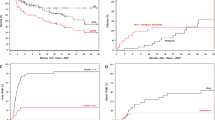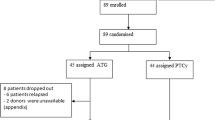Abstract
This is a report of 148 patients with hematologic malignancies who received an unmanipulated haploidentical bone marrow transplant (BMT), followed by post-transplant high-dose cyclophosphamide (PT-CY). All patients received a myeloablative conditioning consisting of thiotepa, busulfan, fludarabine (n=92) or TBI, fludarabine (n=56). The median age was 47 years (17–74); 47 patients were in first remission (CR1), 37 in second remission (CR2) and 64 had an active disease; all patients were first grafts. The diagnosis was acute leukemia (n=75), myelodisplastic syndrome (n=24), myelofibrosis (n=16), high-grade lytmphoma (n=15) and others (n=18). GVHD prophylaxis consisted in PT-CY on days +3 and +5, cyclosporine (from day 0), and mycophenolate (from day +1). The median day for neutrophil engraftment was day +18 (13–32). The cumulative incidence of grades II–IV acute GVHD was 24%, and of grades III–IV GVHD 10%. The incidence of moderate–severe chronic GVHD was 12%. With a median follow-up for the surviving patients of 313 days (100–1162), the cumulative incidence of transplant-related mortality (TRM) is 13%, and the relapse-related death is 23%. The actuarial 22 months overall survival is 77% for CR1 patients, 49% for CR2 patients and 38% for patients grafted in relapse (P<0.001). Major causes of death were relapse (22%), GVHD (2%) and infections (6%). We confirm our initial results, suggesting that a myeloablative conditioning regimen followed by unmanipulated haploidentical BMT with PT-CY, results in a low risk of acute and chronic GVHD and encouraging rates of TRM and overall survival, also for patients with active disease at the time of transplant.
This is a preview of subscription content, access via your institution
Access options
Subscribe to this journal
Receive 12 print issues and online access
$259.00 per year
only $21.58 per issue
Buy this article
- Purchase on Springer Link
- Instant access to full article PDF
Prices may be subject to local taxes which are calculated during checkout

Similar content being viewed by others
References
Aversa F, Tabilio A, Velardi A, Cunningham I, Terenzi A, Falzetti F et al. Treatment of high-risk acute leukemia with T-cell-depleted stem cells from related donors with one fully mismatched HLA haplotype. N Engl J Med 1998; 339: 1186–1193.
Aversa F, Terenzi A, Tabilio A, Falzetti F, Carotti A, Ballanti S et al. Full haplotype-mismatched hematopoietic stem-cell transplantation: a phase II study in patients with acute leukemia at high risk of relapse. J Clin Oncol 2005; 23: 3447–3454.
Handgretinger R, Lang P . The history and future prospective of haplo-identical stem cell transplantation. Cytotherapy 2008; 10: 443–451.
Lu DP, Dong L, Wu T, Huang XJ, Zhang MJ, Han W et al. Conditioning including antithymocyte globulin followed by unmanipulated HLA-mismatched/haploidentical blood and marrow transplantation can achieve comparable outcomes with HLA-identical sibling transplantation. Blood 2006; 107: 3065–3073.
Luznik L, O'Donnell PV, Symons HJ, Chen AR, Leffell MS, Zahurak M et al. HLA-haploidentical bone marrow ransplantation for hematologic malignancies using nonmyeloablative conditioning and high-dose, posttransplantation cyclophosphamide. Biol Blood Marrow Transplant 2008; 14: 641–650.
Di Bartolomeo P, Santarone S, De Angelis G, Picardi A, Bavaro P, Di Bartolomeo E, Olioso P et al. Unmanipulated bone marrow transplantation from haploidentical related donors for patients with high risk hematologic malignancies. Blood 2013; 121: 849–857.
Raj K, Pagliuca A, Bradstock K, Noriega V, Potter V, Streetly M et al. Peripheral blood hematopoietic stem cells for transplantation of hematological diseases from related, haploidentical donors after reduced-intensity conditioning. Biol Blood Marrow Transplant 2014; 20: 890–895.
Passweg JR, Baldomero H, Bregni M, Cesaro S, Dreger P, Duarte RF et al. Hematopoietic SCT in Europe: data and trends in 2011. Bone Marrow Transplant 2013; 48: 1161–1167.
Raiola AM, Dominietto A, Ghiso A, Di Grazia C, Lamparelli T, Gualandi F et al. Unmanipulated Haploidentical Bone Marrow. Transplant and Posttransplantation Cyclophosphamide for Hematologic Malignancies after Myeloablative Conditioning. Biol Blood Marrow Transplant 2013; 19: 117–122.
Acknowledgements
The study was partly supported by Associazione Italiana Ricerca contro il Cancro Milano and Associazione Italiana contro le Leucemie Genova.
Author information
Authors and Affiliations
Corresponding author
Ethics declarations
Competing interests
The authors declare no conflict of interest.
Additional information
This article was published as part of a supplement, supported by WIS-CSP Foundation, in collaboration with Gilead, Milteny Biotec, Gamida cell, Adienne Pharma and Biotech, Medac hematology, Kiadis Pharma and Almog Diagnostic.
Rights and permissions
About this article
Cite this article
Bacigalupo, A., Dominietto, A., Ghiso, A. et al. Unmanipulated haploidentical bone marrow transplantation and post-transplant cyclophosphamide for hematologic malignanices following a myeloablative conditioning: an update. Bone Marrow Transplant 50 (Suppl 2), S37–S39 (2015). https://doi.org/10.1038/bmt.2015.93
Published:
Issue Date:
DOI: https://doi.org/10.1038/bmt.2015.93
This article is cited by
-
“Incidence and significance of donor-specific antibodies in haploidentical stem cell transplantation”
Bone Marrow Transplantation (2023)
-
Effects of second transplantation with T-cell-replete haploidentical graft using low-dose anti-thymocyte globulin on long-term overall survival in pediatric patients with relapse of leukemia after first allogeneic transplantation
International Journal of Hematology (2022)
-
Favorable outcomes of allogeneic hematopoietic stem cell transplantation with fludarabine–bendamustine conditioning and posttransplantation cyclophosphamide in classical Hodgkin lymphoma
International Journal of Hematology (2022)
-
Myeloablative conditioning with thiotepa-busulfan-fludarabine does not improve the outcome of patients transplanted with active leukemia: final results of the GITMO prospective trial GANDALF-01
Bone Marrow Transplantation (2022)
-
Contemporary haploidentical stem cell transplant strategies in children with hematological malignancies
Bone Marrow Transplantation (2021)



